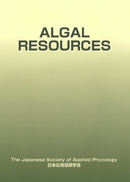Seasonal growth and population structure of hijiki (
Sargassum fusiforme) was surveyed at two rocky reefs contiguous to each other, i.e.
Saba-Shima and
Sen-emon-Dashi, in Hime, Kushimoto-cho, Wakayama Prefecture. In spring, the harvest season of hijiki for fisheries, thalli in
Saba-Shima were significantly larger than thalli in
Sen-emon-Dashi. A permanent quadrat was set at each reef and the growth pattern of hijiki in the quadrat was monitored monthly from June 2012 to April 2013. In the population at
Saba-Shima, main branches had already been developed in many hijiki thalli in June, and their rapid elongation began in November. On the contrary, the population at
Sen-emon-Dashi was dominated by rosette-type thalli with cauline leaves extended radiately and no main branches developed during summer and autumn. Frequency of thalli with developed main branches increased and their rapid elongation began in January at
Sen-emon-Dashi. Even after the onset of rapid branch elongation, daily elongation rate was far larger in the population at
Saba-Shima than in the population at
Sen-emon-Dashi. Difference in seasonal growth and developmental pattern was attributable to the difference in spring thallus size of hijiki between the two reefs.
抄録全体を表示
